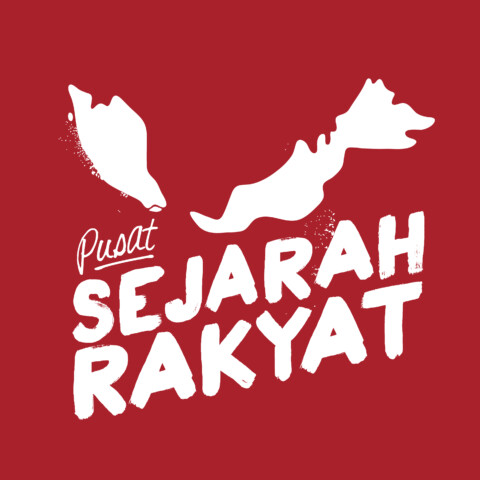Hailing from a pro-government family, Asraf experienced greater political awakenings through student activism when he went to matriculation and university. There, he began his decade-long activism – first with an Islamic student group, then briefly with political parties and finally, being involved full time with the civil society. He talks about his activism journey through various protests in Sabah and then becoming part of the Lawan team in Klang Valley. He is currently senior manager at The Coalition for Clean and Fair Elections (BERSIH).
Can you tell us about yourself?
My name is Mohammad Asraf Sharafi bin Mohammad Azhar. I was born in Alor Setar, Kedah, but my activism started in Sabah, specifically in Universiti Malaysia Sabah (UMS) with the student movements in the mid-2000s. Since then I have been involved in the activism scene with friends for most of the past 17 years, with a brief interlude in party politics for about 4 years.
Did your family play a role in the early days of your activism?
My family background was pro-government, which was UMNO and BN at that time. My mother was a political activist; she was the women’s wing leader for one of the branches in UMNO Alor Setar, while my grandfather was the Deputy Speaker for the Kedah State Legislative Assembly. From what I remember, during the 1990s, we were pro-government. During the 2004 general election when BN won big, our family cheered and I even had fights with our PAS friends.
Afterwards, I entered Kedah Matriculation College (KMK) in Changlun. From there, my views shifted as a result of peer influence, conducting discourse focused on Islamic issues in mosques, usrah groups, and so on. Other than that, we discussed issues that affected the economy, and state violence.
My involvement got more serious when I entered UMS to study agriculture and got involved with PAS’ student wing, GAMIS. Every campus has its Islamist student groups, and more often than not, they’re PAS’ student wings. If that’s not the case, then it’s probably ISMA or IKRAM. There, we talked about student-centric issues, but the usrah syllabus would also include the history of Islamic movements and Qaradhawian thought, then we progressed to the views of Ustaz Fadzil Noor (former PAS president) and the likes. My understanding of the history of politics at that time was shaped through the lens of PAS. At that time, there were already several groups within PAS; one of them was a more pro-ulama group, and the other was deemed the “professional” group akin to Erdogan. Then, there was also the “Anwar” group. I myself was more aligned to the groups labelled as “Erdogan” because of the shifts in local politics as the BN government lost in multiple states in 2008. Islamic movements had to shift their approach to acclimatise to the political shifts, and I found myself being in support with people like Mujahid Yusof Rawa, Khalid Samad, Dr. Hatta Ramli, and Dr. Dzulkefly Ahmad. It was then that they brought these ideas and discourse from a more student-centric approach to Sabahan student movements in UMS and other places. I was the GAMIS state chairperson in 2009, and at that time, the issues that were brought up were those at national scale: anti-ISA, AUKU, alternative media, etc. We campaigned against the consumption of Utusan and Berita Harian, and promoted alternative news outlets such as FMT and MalaysiaKini. We tried to include local issues such as native customary land rights and highlight national issues such as TPPA from a state-level concern too. In fact, one of the first actions against TPPA was done in Sabah. There weren’t a lot of us, only about 20 people in Kota Kinabalu consisting largely of PAS youths to object to TPPA at Sutera Harbour, Tanjung Aru, Sabah.
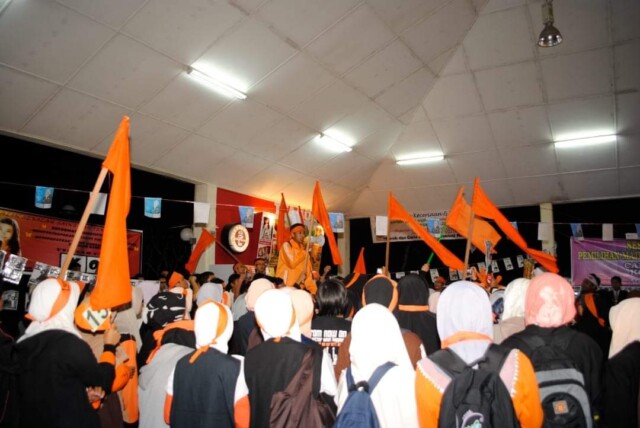
In the early days of his activism, Asraf helped friends in a student group campaigning in campus elections.
What drove you to the student activism journey?
Islamic faith was the main reason, indeed, as brought forth through PAS. At the time, we were taught that an Islamic rule should be established, with the goal of returning the religion’s rule as a sort of caliphate within society. I believed in that ideology at that time because [we were told] the rulers weren’t very Islamic. Issues such as hudud, living costs, Muslim citizen’s economic status weren’t being upheld, and Islam was a sort of solution to social ills. The main challenge was positioning Islam as the solution, so I read a lot of other perspectives. Before that, my [pro-UMNO] views were largely influenced by my family since they were party supporters, but when I got to university, I felt that I had a different insight that would lead to a better government compared to the existing one at that time.
I was actually quite extreme [ideologically] at the time, thus this shift caused clashes in the family. One thing to note was that my dad was very democratic. He knew that he and his wife [my parents] were pro-UMNO and I was pro-PAS and pro-Pakatan Rakyat, so what he did was that 2 days prior to voting day in 2013, we all discussed Malaysian issues and decided that our votes are ours individually. It made me reflect on my own ideologies and realised it was possible to agree to disagree, valuing democracy indeed.
When it came to student activism, how did you first come to involve yourself within the sphere?
I went to the mosque a lot during matriculation, and it continued into university. I didn’t immediately joined PAS’ usrah (Islamic lectures). Instead, I listened to a lot of Prosperous Justice Party’s (PKS, an Indonesian political party) lectures, and followed them for about 1 semester. Their content wasn’t political actually; rather, it was about how to improve your prayers, relationship with God, and live life on the religious path. I wasn’t so concrete about my own involvement, because they were so secretive – their group didn’t have a name. They just named things “Ikhwan”, and whether this “Ikhwan” was the group’s name or member names, I don’t know. One of the members, a doctor, just said that they were an Indonesian Islamic religious movement. Going back to the content, despite them not centering their lectures around politics, they did have lots of open discussions about current issues back then.
When I was in the second semester, my roommate asked me to join him in a PAS usrah [while not directly mentioning it was under PAS]. So, there was an open debate about which political party to support: PAS was Islamist. We were told that Keadilan was friendly to PAS but they had short-term vision; DAP was secularist, and so was UMNO. After discussing each party’s strength and weakness, the usrah concluded that PAS had it all, which resulted in me joining them. There were many usrah groups, and it just so happened that I was a late bloomer, joining in only in Semester 2 when others were normally involved by Semester 1. In my group, there were only 2 people, and we weren’t super active with PAS after its fragmentation. Nonetheless, the 2 of us followed PAS until our graduation.
That’s interesting. When it came to mobilisation, were the same circles used to mobilise as well? How did mobilisation work during your time as a student activist?
I think the advantage of being in the PAS youth wing and GAMIS was that there were plenty of members, so it was easy to mobilize since we could bring our own members. But in Sabah, it was quite different because not many were brave enough to go to the streets in fear of the police and AUKU (a law that was then curtailing students’ political participation). They were afraid of being thrown out of university despite the issues being people-centric, not party-centric. For example, if you brought forth anti-ISA or native customary land right sentiments, you’d be labeled as pro-opposition. There were 3 campuses where we mobilised a lot of members and usrah members, the main one being UMS and polytechnics being the other two. When you join a PAS usrah, there will be a leader called an “amir”. I was the amir in UMS campus and we mobilized on our own initiative.
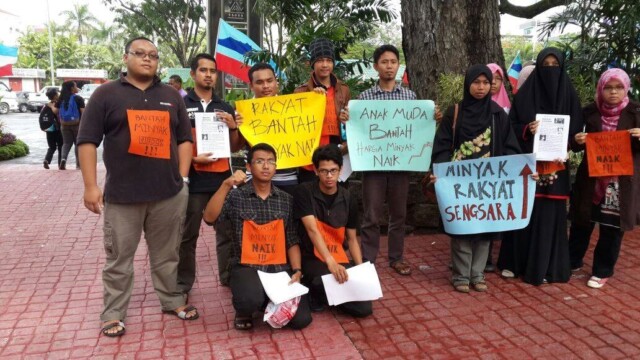
Protesting with friends on the rising cost of living in his youth days.
The situation in Sabah was fascinating because PAS didn’t even have a seat in the local DUN, but the network was there.
The network was indeed there, but it wasn’t that huge, actually. But because it was made by the students, it got big. It’s been a while since there was a student-led protest in Sabah, the last one being during the early 2000s or late 1990s when the UMS campus was just opening up.
Can you tell us about the first protest you joined or organized?
The first protest that I joined was a pro-Palestine protest in 2008 led by a university senior. I was drawn to this “heading to the streets” approach, which prompted me to delve further into student activism readings.
The protest was done after Friday prayers near the UMS mosque. There were a group of students, including female PAS youth wing members. They did speeches, made demands towards the Malaysian government and condemned Israel for their oppression towards Palestinians. Their approach was so “merakyat”, the speaker was a small hailer— so small, in fact, that I think if there were more than 30 people, the people at the back wouldn’t be able to hear. They raised people on each other’s shoulders, which I thought was cool [even though I wasn’t that radical at that time]. It made me realized that there are other methods to talk to others, such as gathering people in a small rally. It also helped that they had a competent orator.
The first protest I organised was in 2009.. There was a UMNO gathering in UMS, which was wrong because political parties cannot enter university campuses. I contacted Shazni Munir, then GAMIS national vice chair, and told him we in UMS are going to organize a protest. Me and 6 other UMS friends (2 of which were Chinese DAP members; the rest were from PAS usrah members) opened a hand-painted banner and came to the venue even before the event started, right at the front gate. Of course, UMNO guys beat us, pulling our hairs and all. The organizers, some of them were elected representatives, punched me. Thankfully, RELA officers surrounded us so we weren’t hurt very badly. We organised this spontaneously and by ourselves since I only got to know about this event through the banners hung the day before. We wrote down our plans at a coffee shop on a piece of tissue. We were so spirited that we thought, “If we get punished for this, so be it.” This was the first protest I organised and I got “AUKU-ed” and a warning letter for it.
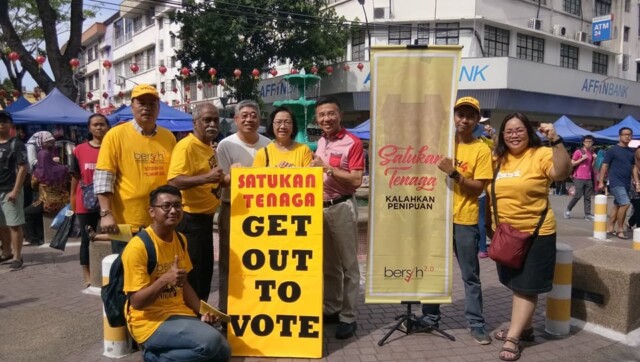
Bersih was not just a protest held in Klang Valley, but also organically organized by people all over the country. Here, Asraf and comrades at Bersih Sabah held at Kota Kinabalu.
After that first protest you organised, did you go on to join more protests?
I joined the Bersih 2 rally in July 2009 before organising my own protest, which was probably the reason why I was bold enough to do that, kind of like an activist version of baptism of fire. I wasn’t there during the Bersih 3 rally because I was at an agricultural estate doing my industrial training. Then, I joined a native customary land rally at Kota Kinabalu in 2011 under TABAH. Afterwards, in 2012, we made a group called GEGAR that organised a few more protests, such as a flash mob to abolish ISA. Our biggest rally was Sabah Bangkit in early 2012, rallying all the opposition political parties such as DAP, Keadilan, MBP as well as NGOs and youth groups. We put forward 11 demands, including Internet connectivity, roads, education, oil royalty, and the such. I had experience doing media work at this time which involved writing statements and communications. At this time, I was about to graduate, and this committee consisted of youth movement members because GAMIS and Pro-M were under a different leadership. We wanted to pull young people into the movement that weren’t necessarily from the PAS circle, like those from Buku Jalanan.
In 2013, I was less involved in organising demonstrations and was more focused on party campaign operations in light of state elections in Sepanggar, Sabah for PAS. My involvements were all in Sabah and not Kedah so that my family couldn’t intervene. After the election, I was fired from my post due to internal tension with Pemuda PAS due to my anti-UMNO protest, but I was still a PAS member, so I worked with PAS Sepanggar. During this time period (2013 -2015), I wasn’t super active in protests, but I took on minor involvements such as protesting against rising oil prices.
I came back to the demonstration scene in 2015 through the May Day rally in Sabah which coincided with the anti-GST rally with GEGAR and Jannie Lasimbang who was a Human Rights Commissioner (SUHAKAM) based in Sabah and Jaringan Orang Asal Sabah (JOAS). Sabah is fascinating in the sense that the issue wasn’t focused on minimum wage; rather, it intertwined with native customary land issues, and a myriad of other issues. Other than that, I was a marshall for a state-level Bersih 4 rally in Tanjung Lipat, Sabah in 2015. When we [GEGAR] did the Sabah Bangkit rally, Jannie became an observer of the rally and somewhat defended us, knowing us from there. Subsequently, we did meetings and memorandums with SUHAKAM, and were called to jointly organise for the Bersih 4 rally.
In 2016, I was involved in the Bersih 5 rally in Sabah, but since Bersih 5 has a different approach with its convoy method, we made it a state-wide approach. GEGAR was still the backbone of the Bersih Sabah operations, just 4 main persons who were from Pro-M KK and Pro-M Labuan. At this time, I was still working for the PAS office in Sepanggar. I was the head marshal for the Bersih 5 rally in Sabah. During Tangkap MO1, I was one of those people in the early meetings that helped paint banners and prepare props, including painting the Najib caricature.
There were no major rallies in 2017-18 to make way for the general elections. On 16 September 2019, there was the Sabah Malaysia Day protest where I played a background role since it was student-led. Mukmin Nantang from Borneo Komrad got arrested though.
2021 was when I came to KL in March and organised Lawan (the first protest I organised in KL).
Can you elaborate further on the role of a (head) marshall?
We take care of security during a protest. In Sabah, some marshals guard equipment like speakers, hailers, lights, lorries, etc. Others take care of participants since there weren’t a lot of them. For every 10 people, there was 1 marshal during the Bersih 4 rally in Sabah. During the Bersih 5 rally in Sabah, we had around 100 marshals just to protect participants from provocations and mitigate any arising security matters. Some other marshals were frontliners, called “ribat” in Arabic.
I was involved in a lot of programmes under Unit AMAL to do fieldwork. For marshal work specifically, we sourced trainers from West Malaysia and organised police, human rights, and constitution workshops for marshals in Sabah. We got the material from Syukri Razab who was then with SUARAM (human rights NGO) and imparted the knowledge to those in Sabah. Some of the things we taught were how to handle police, what to do when arrested or detained under lockups. Some PAS people in Sabah weren’t that bold to organize demonstrations and thought it was unsuitable, which explained why there were conflicts with the protest we organised previously.
During Bersih 4 and 5 rallies in Sabah, a lot of marshals were indigenous people supplied from PACOS, consisting of aunties and uncles who were able-bodied from carrying stuff on a daily basis. They would also undergo training and simulations 2-3 days before the protest. Thankfully, PACOS has a large, closed venue in Penampang to host these training sessions, so it was beneficial to collaborate with them. They also helped with equipment.

Entering a village in Ulu Papar, Sabah to oppose dam construction.
How was your experience dealing with the authorities?
Special branch (SB) officers will always be present. Regular police in uniforms or vests will provoke, while SB will be more subtle about it, choosing to go undercover and playing with emotions rather than physical provocation. We were called to the station for questioning, especially in 2015 for flash mobs and protests at Gaya Street. That’s where the media and crowd is. There was a lot of traffic, and you could stand at the fountain in the middle of the street to give speeches. Before this, there were no police, but due to repeated protests at that venue, until now there is constant police presence at that area.
Some common venues for our protests were the UMS mosque and in front of lecture halls; Gaya Street, Padang Merdeka, Tanjung Lipat; and Taman Ujana. For the convoy, we went to the main towns and cities, like Penampang, Inanam, Kota Kinabalu; Tuaran, Kudat, Lahad Datu; Tawau, Semporna, Sandakan, Kinabatangan, and Keningau. When choosing a venue, the primary consideration is safety, security and access. For example, the bus access at Padang Merdeka attracts a lot of people, same goes with Gaya Street, since it cannot be closed due to tourist traffic. Some locations are easy to escape from the police and difficult for them to surround us.
As organisers, we had to announce and negotiate with police before each protest. Police would say the gathering was illegal or the premise was not allowed, so we discussed with other activists about this since it wasn’t going to be allowed. But due to regulations regarding assembling for the Sabah Bangkit rally, what we did was we just posted the notice by mail and left it at that. Because of that rally, they closed the front doors of the local courthall. During negotiations with the police at the police stations, they would give alternatives like doing it in halls and whatnot. Truthfully, it wasn’t really a negotiation anyways; we just showed face there. Under the Peaceful Assembly Act (PPA), they couldn’t arrest us. Police will use laws other than the peaceful assembly act to arrest and hold activists. One time, during the anti-TPPA rally, we were arrested under the Dangerous Drug Act which was weird because it was during the fasting month. They would use just about any law to arrest protesters. I had to do a urine test because of it.
Do you feel fear when confronted by the police? How did you deal with it?
I was always anxious when meeting with the police, because I would spend time imagining what kind of laws they would use, whether I will be locked up, how to pay the fine, etc. It is not a bad thing to have fear because those without fear will not have limits (to do anything) and that may damage the cause. Those who are more seasoned will reassure people and say that lawyers are standing by, which helps to provide relief to those in anxiety. Legal support in Sabah is different in KL. You could easily get like 20 lawyers willing to help at 1 am in KL, whereas in Sabah, if you call 10 lawyers, you can’t guarantee you’ll get even 1. Hence, we had to find party-affiliated lawyers from PKR, PAS, etc. We had to pretend to the protesters that we had lawyers already even if that wasn’t always true. Usually in Kota Kinabalu, the spot where we’d get arrested was Karamunsing Mall.
How long does it take to organise a protest, usually?
Most protests at most were in the planning for only 2 or 3 months. Even the MO1 protest had like 2-3 weeks of preparation time since the people were getting angry, same with Bersih 4 rally with the 1MDB issue. However, the network we had were longtime friends from different youth groups. Some groups would have recurrent roles with banners and security.
The Lawan protest had a lot of meetings since there were 3 protests leading up to the main Lawan rally. The first was the protest about the Election Commission’s decision to delay the implementation of Undi18. Then, it was the “Buka Parliament” rally which gave birth to the structure of Secretariat Solidariti Rakyat (SSR). After this, we had serious discussions about future plans, holding weekly meetings in the leadup to protests and Lawan itself for the SSR committee.
From my experience, all protests had a lot of meetings, especially the week prior to D-day. A lot of planning goes into a protest such as strategy, logistics, security, medical teams, venue, etc. At the very least, there were like 10 meetings, especially among core organising members.
There’s definitely a variety of protest forms that you’ve been through. Can you talk further about Lawan since it was quite recent and you were one of the spokespersons?
Sabah’s rallies were a bit more hardcore but small-scale with its street rallies and placards. The more creative protests are held in Klang Valley, like for example, someone named Dan from Demokrat suggested wearing kain pelikat, the name of Buka Puasa Parlimen, and the venue itself. Sarawak was blocked from doing this convoy.
Other than this, what caught the attention of media and authorities was the silent candlelight vigil at Dataran Merdeka with the faux dead body prop. It was moved by SSR people. The (Muhyddin Yassin) government was shocked at the car protest convoy since it was mobilised in almost every state and it carried the black flag. It was hard to find lawyers all over the country, and the police intimidated the protesters and their families with fines and arrests. They were adamant about scanning for driving licenses and license plates. They didn’t intimidate us to stop us from the convoy itself; rather, it was to discourage us psychologically from these daring acts altogether.
Covid was a big concern for the Lawan protests, so we asked for advice from the Doktor Hartal group. We regularly reminded people of hand sanitisers and social distancing. There was a mini site setup for protest procedures and guidelines that gave people, especially young people confidence in organisers’ capabilities to handle this protest. They really did comply with the regulations and guidelines we set.
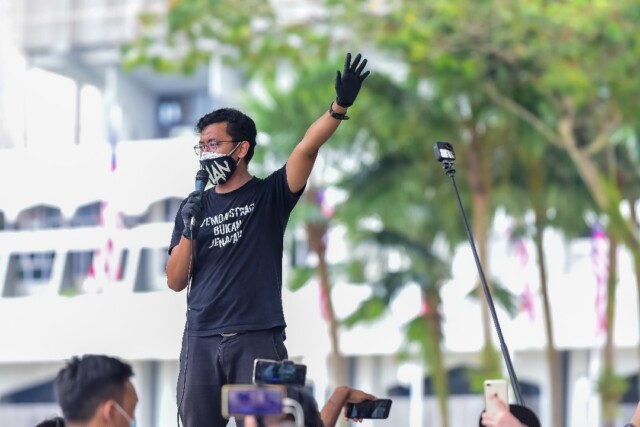
Asraf became the impromptu spokesperson for the Lawan protest organized by SSR during the Covid-19 lockdown in 2021.
Lawan was kind of an introduction to Undi18 group’s integration into the activism sphere. How was your reception towards them?
Honestly, I can’t comment much because I was new to the KL activist scene and it was the second lockdown at that time, too. So my recollection of activist friends were the older batch, like those from Liga Pemuda Malaysia, and others who already embarked on party politics. So the group I met during Lawan was Undi18, Misi:Solidariti, Challenger, Demokrat UM & Kebangsaan, PSM (socialist party), and many others that I wasn’t familiar with. Nonetheless, there were fresh ideas from these groups. I did not think that I would end up being the spokesperson, but there I was, coincidentally, for the demonstration at Dataran Merdeka because there was no official spokesperson. I was thinking of passing it to the younger people, but they probably needed guidance on how to do it, hence why I was there.
The response was much more positive on Twitter compared to Facebook since there was some movement on Twitter in favour of the black flag movement. People who came for Lawan were new to protests and civil society, and the lack of political party support helped bring non-partisan people in.
During the years of 2018-2020, there was a gap in protests except in Sabah probably. Political parties were in support in some of the minor movements, but they were very wary about showing support in fear of public backlash. This might explain our desire to go out during Lawan.
During Lawan, you had the opportunity to work with new and looser social collectives. How was the experience like?
Well it was quite similar to my time with GEGAR. There were only small, independent groups that were left-leaning. Probably around 3 groups in total, the biggest of which was PACOS which was around since the 1980s.
So during Lawan, I was introduced to these new groups. Many of them were advocating for human rights and proletariat issues such as death in custody, migrant rights; queer rights and such. They were also young in age; I was 32 years old then, while some of them were in their early 20s. There was a 10-year age gap, so we trusted the younger people with social media work since they were more literate and had a stronger online presence than us.
I did not have much of a clash with younger activists since they were in charge of that [social media work], while I dealt with on-the-ground work like dealing with the police and press statements. At most, the clashes that happened between groups were opinions on political involvement. We were concerned about political parties riding on Lawan for their own political agenda.
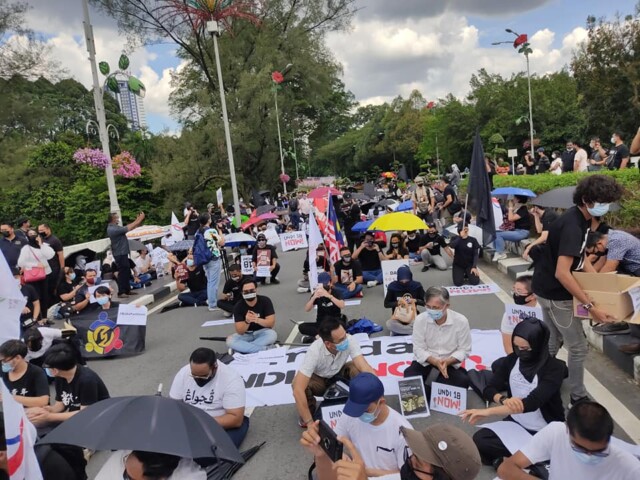
Pictures taken by Asraf Sharafi during protest.
Can you share with us the thought process on choosing the protest venue for Lawan?
3 places were proposed: Pasar Seni, Dataran Merdeka; and Padang Timur. We ultimately decided we wanted to head to Dataran Merdeka, congregating at the Masjid Jamek area first for ease of access, mobility, and the fact that the place was shaded! The police were outnumbered by us and they were surprised because all this happened despite the roadblocks and police at train stations.
Could you share with us the protest tactics and strategies used at that time?
The strategy didn’t change much, but perhaps the tactics did, like how to build momentum. We planned to do 2-3 smaller protests leading up to Lawan, especially that Undi18 protest which helped get new people and ideas. The first protest was planned literally a day before it happened, hence why we didn’t do much at that time. Tactics would change, of course, like convoys, flash mobs, etc.
Hashtags that were used for social media for Lawan were #LAWAN and #6Tuntutan. We also implemented the black flag; I don’t know whether we initiated the idea first, but we suddenly had it and it became a symbol to fight against the system. This was to differentiate ourselves from “Kita Lawan” protest, which was another thing (with a similar name) during the Tangkap MO1 rally.
What led you to decide to head back to the streets again?
It was to return the power back to the people, which became the main objective for the rally. Statements and social media weren’t enough. Bringing people onto the streets was difficult but that makes it more meaningful, as opposed to social media. When they see that people were heading to the streets in the midst of a lockdown, it shows that there’s truly something serious here.
Protests are necessary to demand for immediate change and signal that people are desperate. The government does not take social media anger as seriously since its visibility is only digital, but when they see people taking it to the streets, they sense the urgency that we project to the cause.
In all the years you’ve been involved in protests, do you believe they’re impactful? Would you say you see tangible changes?
Well, Bersih 4 and 5 rallies ultimately caused a change in government. The other protests were to empower people to become bolder and became a way to teach democracy.
I particularly favour protests because I want to eradicate the stigma and association of protests with violence. I want to normalise peaceful protests, and even when my parents disagreed with me attending them, I could enlighten them that protests are not riots. Not every protest will change policy but it’s a process that could lead to greater change. Even policymakers in a government can’t do change overnight, what more of small protests. Even changing a government does not necessarily change policy.
How would you categorize the different protests that you have been involved in throughout the past decade? Like is sending a memorandum considered a protest?
I think sending memorandums isn’t considered a protest; you’re just pulling a crowd and rallying. Protests are where there are demands and critique of the government voiced out by the people. So the definition of a protest to me is when there is critique of the government.
In Sabah, I don’t really think there’s very gimmicky actions done during protests. I’d say that even for Lawan, the only gimmicky act was the faux dead body prop. We wanted to use a real tombstone for future Lawan protests as a prop, but we ended up not using it because there were no other subsequent Lawan protests. Lawan was possibly a signal the people did not want Muhyiddin as Prime Minister, and when the first demand was met (when he stepped down), the momentum was lost. There was discussion among SSR members whether to claim this win, or to credit this to political parties.
Usually, we decide we want to do a protest first (in response to certain situations) before we actually develop the demands, not the other way around. Ultimately, demonstrations are the last resort for people to express themselves.
What would you say is the impact of protest on your life trajectory and outlook?
I cannot imagine how my life would be if I didn’t involve myself in protests. I became less partisan as a result of my involvement. I think if I didn’t join, I’d be blinded by party ideology.
I studied agriculture but I became interested in elections. Not sure why, but I was fascinated by politics and its intrigue. If I didn’t join protests, I could have ended up taking care of a plantation. During the Occupy Dataran and Bersih 3 rally, I was in an estate doing my training, but I felt moved seeing people protesting and I felt a fear of missing out. The rest is history.
